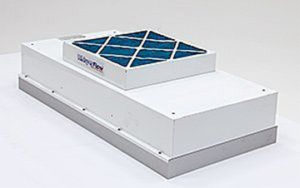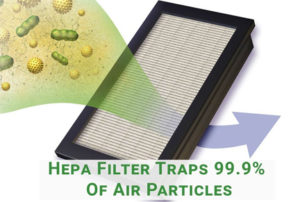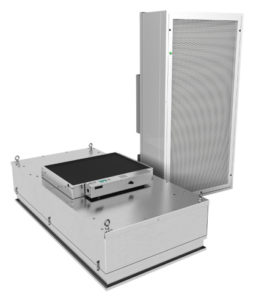In the liquid packaging industry, you are dealing with a wide range of liquid products from a number of different industries. Some of these liquid products can be extremely delicate or volatile liquids that need to be handled and processed with a certain amount of care and cleanliness.

Products from these types of industries (i.e. pharmaceutical, biotech, medical, chemical, etc.) can be highly regulated and require the use of HEPA filtration systems throughout their manufacturing processes.
What is a HEPA filtration system and how does it work? In FILAMATIC’s latest article, we go over a few general areas that are important to know when talking about HEPA filtration systems.
What is a HEPA filtration system?
As defined by the US Department of Energy, HEPA stands for High-Efficiency Particulate Air. The most basic way to describe what HEPA air filters do is that they provide clean air into a room. HEPA filtration systems do this by removing small particulates in the air with filters. This can include mold, dust, bacteria, pollen, viruses, VOCs (volatile organic compounds) or anything that is hard to see with the naked eye.
HEPA filters are used in many applications across industries – not only within the liquid filling and packaging industry. HEPA filters have been around since the 1940s and are common in today’s modern society. You will find HEPA filtration systems in the HVAC system in your house, vacuum cleaners, and even stand-alone HEPA units (which have become popular during the COVID-19, aka coronavirus).
How do HEPA filters work?
The basic elements of a HEPA filter system is a fan unit and a filter.
When talking about HEPA filters in a room, they are usually mounted in the ceiling. The fan will push air down through the filter while controlling the amount of air that comes through. It’s taking the air outside of the cleanroom and filtering it as it pushes air into the space. On most larger liquid filling systems, the HEPA units are usually secured at the top of the machine within an enclosed capture.
HEPA filters are made from glass or synthetic materials and are randomly aligned to catch particulates in the air. Over time the filter will need to be replaced as it catches more and more particulates in the air. A new filter will be free-flowing and much more efficient in doing its job. An older filter will have particulates in it, and less air that goes through. Many machines are outfitted with a pressure sensor, that would allow you to determine when the filter needs to be replaced. As more and more particulates get trapped, the pressure sensor will pick that up and alert the technician it is in need of replacement.
When do you need to use HEPA filtration system?
In the packaging industry, it is common to see HEPA filtration systems used in pharmaceutical applications. For instance, vaccines (highest level), ocular eye products and anything that is injected or consumed by humans in a medical sense. This includes cough medicines, over the counter drugs and prescription medications.
We also see the need to use HEPA filtration on liquid filling machines for diagnostic and biotech applications. Diagnostic liquids, such as reagents, require a low particulate count in the air for filling. Electronics and manufacturing of sensitive electrical components, such as chips and processors for computers and other handheld devices also require HEPA filtration.
So you know about ISO
As we discussed, a clean environment for liquid filling is essential for many applications. Cleanrooms and packaging machines, in general, also have different ratings and classifications. But the formal rating that is followed by the the majority within the Untied States and Canada is the ISO (International Organization for Standardization).
You can see the classifications below. ISO ratings are standardized by the microns of the particulates in the air. The number on the right is the microns per cubic meter allowed for each ISO classification.
| ISO-8 | 100,000 |
| ISO-7 | 10,000 |
| ISO-6 | 1,000 |
| ISO-5 | 100 |
| ISO-4 | 10 |
| ISO-3 | 1 |
You would think the higher the number, the better. It is actually reversed in this case as you can see from the chart above. The lower the ISO number the cleaner the environment.
The classification goes from ISO-1 to ISO-9. Most ISO environments you see in the packaging business are in the ISO-5 to ISO-7 range.
How do you make an ISO environment?
You need a percentage of HEPA units over a given space to achieve a cleanroom. Typically, that’s a 60% – 80% coverage range. That may be 3-4 HEPA filters over a space but it can vary. The level of ISO requirements and HEPA filter units needed is determined by the actual application.
In the liquid filling industry, this could mean HEPA units over the filling and capping areas – where it is most susceptible to have particulates falling into open containers. The labeling function of the system is typically located outside the controlled space, the cleanroom, as the action of labeling creates an inordinate amount of air particulates.  One thing to realize is that you cannot have structures or moving parts of the machine blocking the airflow for filling or capping. What does that mean? It means that certain elements of the system (robotic arms, support structures, etc.) cannot be sitting above the container or blocking the airflow pushing down into the environment. These and many other areas are considerations when building monoblocs with HEPA and ISO requirements.
One thing to realize is that you cannot have structures or moving parts of the machine blocking the airflow for filling or capping. What does that mean? It means that certain elements of the system (robotic arms, support structures, etc.) cannot be sitting above the container or blocking the airflow pushing down into the environment. These and many other areas are considerations when building monoblocs with HEPA and ISO requirements.
On monoblocs, guarding is designed to allow the airflow down and through the bottom of machine to allow air to escape. This helps to guarantee air is going to be filtered and air will blow out and around the machine – allowing for recirculation.
A common occurrence is when a customer wants to put a HEPA filter onto a monobloc where at the facility the machine will be going into an already HEPA filtration room. By doing this, the customer can enhance ISO levels – when discussing a standalone Monobloc with HEPA units, we’re in the ISO-7 range. But if the monobloc with HEPA units is sitting in a cleanroom already providing HEPA filtration, it can achieve an even stronger ISO rating, something in the range of an ISO-5.
How do you test a HEPA filtration system?
There are many different, complex and expensive ways to test airflow in your HEPA filtration system. However, the simplest, inexpensive and most common method is using a smoke machine to see how the airflow moves. Engineers need to make sure airflow is not obstructed in the areas above where the open container sits on the line or where capping occurs. Blockages, turbulence, or smoke sitting in a stagnant position identifies a poor airflow. The airflow needs to pass smoothly and quickly around the entire liquid filling operation for an ideal clean liquid filling environment.
We hope the above blog on Filtration Systems was informative and answered a few general questions surrounding filtration systems. For over 70 years, FILAMATIC has provided the widest range of liquid filling equipment while delivering the lowest cost of ownership to our customers. We excel in flexible, customized solutions for every stage of your business growth. Whether you require a single machine, a complete turnkey solution, or a fully-automated, integrated Monobloc system, we have the experience to ensure your satisfaction is exceeded.
For more information on our liquid filling solutions, please call 866.258.1914 or visit www.filamatic.com/contact-us.
